How Illinois University Presidents Value Students for Funding | Breakthrough Ideas
How Illinois University Presidents Value Students for Funding | Breakthrough Ideas
Thank you to State Senator Chapin Rose for bringing this issue to my attention. I interviewed him on my radio show Sunday, April 21, 2024. That interview can heard at this link: https://560theanswer.com/radioshow/the-real-story, beginning at 46:09.
Public universities in Illinois are teeing up the next scam in this state. And if it comes to fruition, it is likely they will find themselves embroiled in a lawsuit all the way to the US Supreme Court.
The Illinois Board of Higher Education, progressive Democrat state legislators, and university presidents have devised a plan to fund higher education based on race.
These over-educated elitists sitting in their academic bubble and seeping in their racial equity dogma have literally put a price on students based only on race.
One of their proposed adjustments for additional money assigns a Black student’s worth at $6,000, a Hispanic student $4,000, and a student from a rural district $2,000. If they admit a Black rural student, then the “Equity Adjustment” is stackable to a maximum of $8,000.
White and Asian students don’t merit any additional money.
The highly credentialed academics spent two years on their plan. But a simple reading of the Civil Rights Act and the recent Supreme Court decision forbidding race-based admissions should have prevented them from wasting their time.
New Higher Education Funding Report Says Illinois Higher Education is Systemically Racist.
In March 2024, the Commission on Equitable Public University Funding released the results of their study in a 89-page report which is linked HERE. That Commission was established under Public Act 102-0570 in 2021 under the premise that Illinois higher education is systemically racist. The opening lines of the Public Act notes, “Historical and continued systemic racism has created significant disparities in college access, affordability, and completion for Black, Latinx, and other underrepresented and historically underserved students in this State.”
The goal of the Commission, according to the report, was to recommend, “specific data-driven criteria and approaches to the General Assembly to adequately, equitably, and stably fund public universities in this State and to evaluate existing funding methods.”
The full Commission included “33 members, with representatives from the General Assembly, each of the 12 universities, advocacy organizations, fiscal policy organizations, faculty, a health care expert, a legal expert, a public university student, and a member of the Illinois Student Assistance Commission.”
Apparently, common sense was checked at the door before every commission meeting.
These experts made recommendations to, “recognize and address both the historic inequities underlying Illinois’ access and attainment gaps among different groups of students as well as the unique institutional missions and characteristics across the state.”
However, what’s obvious is that the entire aim of the report is to get a guarantee in law for more funding for higher education. To sell that increased funding, the bureaucrats wrapped their findings in equity arguments and asserted that universities are currently underfunded.
The Commission acknowledges that they are dove-tailing off the passage of the Evidenced-Based Funding formula passed in 2017, which changed how we fund K-12 education in Illinois. That model has pushed billions in new funding to local schools based on the notion that schools in Illinois were not adequately funded, and if only they were, then academic achievement would follow.
Like the EBF model – the Equity Adjustment Funding EAF (my abbreviated term) even calls for a hold harmless provision in the funding formula so that base funding never drops at any university. This provision alone, written into law, ensures school districts and campuses are never consolidated and right-sized.
If the System’s Racist, Who’s Running the System?
Let’s look again at the impetus for the Commission – to correct systematically racist policies in higher education that have prevented underrepresented minorities from graduating.
The report includes this chart to illustrate what they say is systemic racism. It simply show that minority enrollment has declined 7% for Latinos and 6% for Blacks in the last five years. White enrollment is also down 3.5%. This isn’t unusal. Illinois enrollment between 2012 and 2022 dropped 27%. It’s likely students are finding more affordable options elsewhere.
The chart says nothing as to why minority students are not entering and graduating at the same rates as white and Asian (also a minority) students. In actuality, Illinois public universities are bending over backward to take in minority students and give them fully funded educations, and they have been doing so for years. Seven years ago, at a private meeting with the Chancellor for UIC in his office, he said that 40% of the students pay less than $4,000 to attend school there. If that’s not affordable, then I don’t know what is.
Just two weeks ago, the NIU President bragged in a House hearing that 43% of the students pay no tuition or fees to attend. She also mentioned a special scholarship NIU grants just for Black students and that the Hispanic enrollment at NIU has reached new highs as they aggressively recruit Hispanic students.
In that same hearing before the Illinois House Appropriations Committee on Higher Education, the representative from the Illinois Board of Higher Education bragged about bringing in people from the Department of Human Services to assess students’ qualifications for food stamps, state-paid childcare, and housing support. In Illinois, they are signing kids up for classes and enrolling them in public aid programs at the same time.
A second chart is so nakedly racist and demeaning it is hard to believe that the Commission put it together.
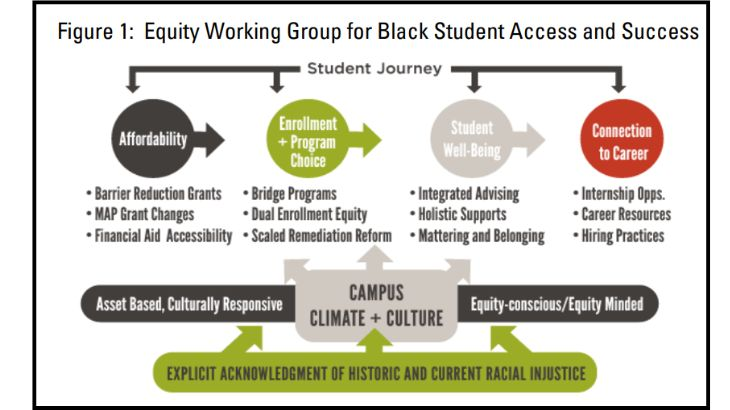
It’s as if the goal was to put as many diversity cliques and terms as possible in one chart. What does this all mean? What appears to be happening is that instead of pulling students along the success path, the system described above carries them through, providing a safety net at every point, requiring little self-motivation from the student. This chart depicts a racist system and assumes that minority students can’t make it on their own.
On page 25 of the report, the Commission shows the numbers for one of the Equity Adjustments in the new funding formula. The formula, just like EBF, is overly complicated. Additional Equity Adjustments are made based on the concentration of minorities at each institution. This chart shows the different economic value to universities of the different races. This formula would incentivize universities to admit minorities for greater funding. Here’s where the value of $6,000 for a Black student, $4,000 for a Hispanic, and $2,000 for a rural student comes from.
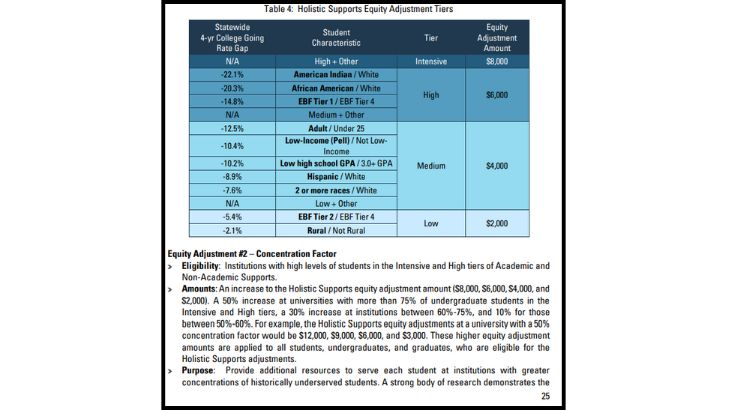
An Alternate View on Education Funding in Illinois and Comparison to Other States
The Commission report fails to tell the whole story about higher education funding in Illinois. The State Higher Education Executive Officers Association FY22 Finance report explains all the gaps – all the other information that is important to assess.
The following charts come from the report referenced above.
Illinois ranks number one in the amount of state support for higher education, giving nearly $23,000 in funding per student to our universities.
The next closest state is Alaska at $18,436. The U.S. average is $10,237.
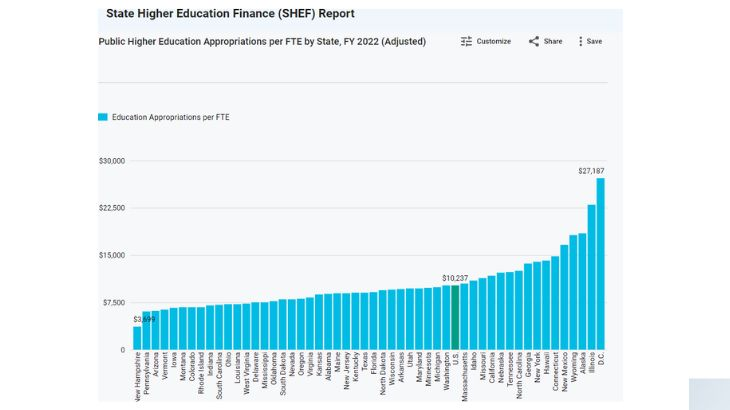
Here’s a similar chart showing both state support and tuition and fees collected. Again Illinois is NUMBER 1 – by a longshot!
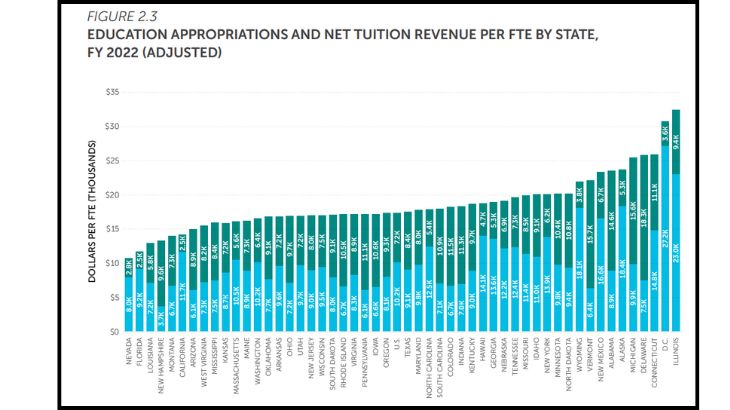
Maybe the Commission can understand a color-coded map better than a complicated graph. Illinois stands out in this chart showing how much taxpayers are already burdened with in support of higher education.
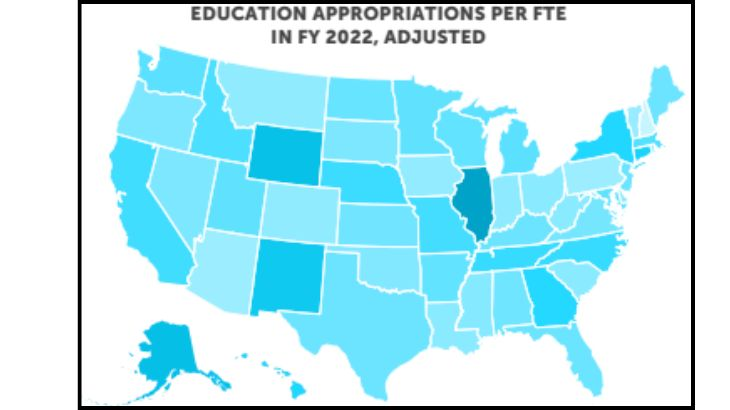
Let’s go a little further. In testimony last week, U of I President Killeen said that their funding is way behind inflation and, without being specific about the timeframe, that their buying power has decreased by 40% over decades.
The Commission included the chart below in their report to make a similar point.
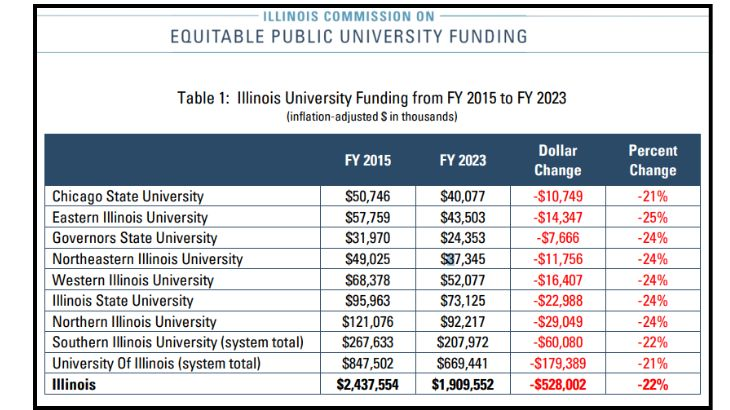
While buying power decreased from FY15-FY23, guess what else has decreased in Illinois – overall enrollment.
SHEEO analysis shows is enrolllment in Illinois universities dropped 27% between 2012 and 2022. President Killeen should be arguing for consolidation and right-sizing of our university system instead of blanket increases. Shockingly, Illinois is the only state to have lost enrollment since 1980. (To see the chart more clearly, go to page 38 of this report https://shef.sheeo.org/wp-content/uploads/2023/05/SHEEO_SHEF_FY22_Report.pdf)
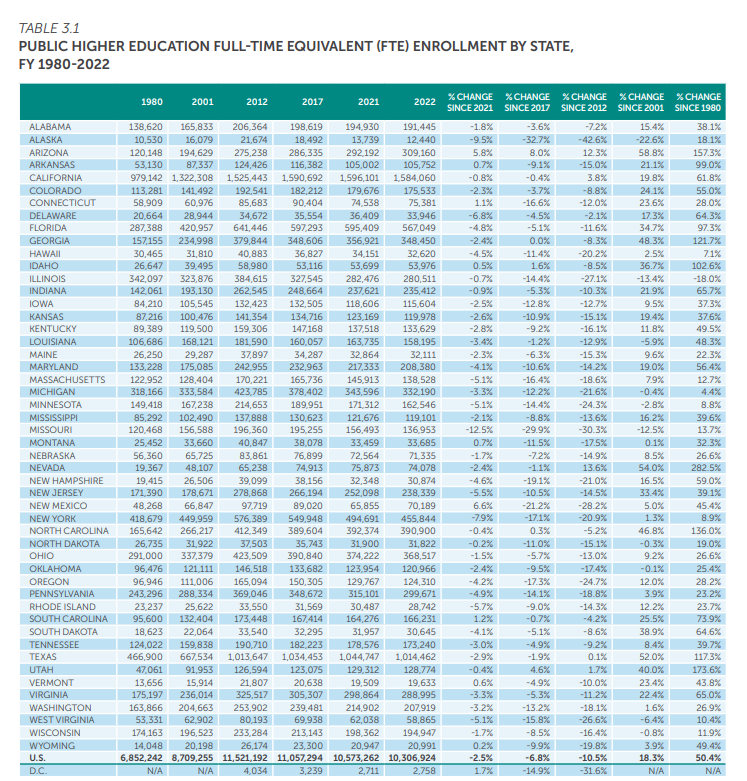
Another chart from that same report shows that Illinois has outpaced other states in the increases in state spending. Since 2012, state spending on higher education is up 53%. (This graph is on page 45 of the report linked above.)
Illinois spending per FTE was $14,975 in 2012 and increased to $22,970 in 2022. As the Commission indicated, spending has increased even more in the last two years.
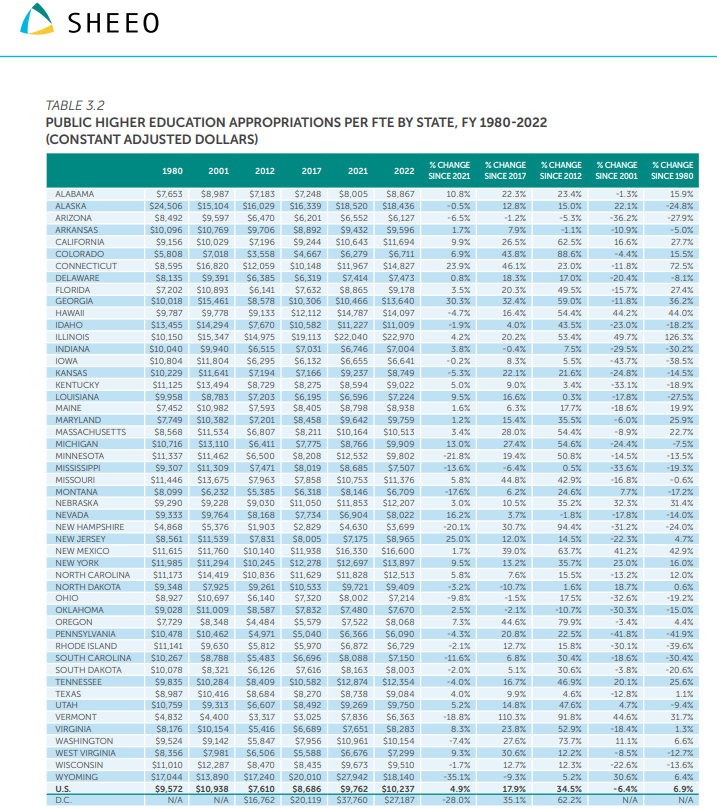
NOW – I already know what people in higher education are going to say about the SHEEO information on spending. They are going to say that SHEEO includes Illinois spending on pensions in their calculation of state support. Yes, they do! And they should – it is a massive amount of money and a cost to the taxpayer. Pension costs account for about 40% of the state-level support for higher education in Illinois. But, even accounting for 40% of support going to pensions, Illinois is still in the top ten for state-level support to higher education.
Illinois is More Expensive Than Its Peers
The EIU President mentioned in testimony last week that he was proud that Eastern Illinois University has the lowest tuition and fees among Illinois public universities. Compared to its peers in the Ohio Valley Conference, however, it is the most expensive among other public institutions. Here is a chart from this source: https://www.collegetuitioncompare.com/best-schools/ohio-valley-conference/
EIU instate undergraduate tuition and fees is $13,403 . The average in their conference is $10,338, making EIU 30% higher than the average of their peer institutions. The outlier in the chart is the private school Belmont University at $41,320.
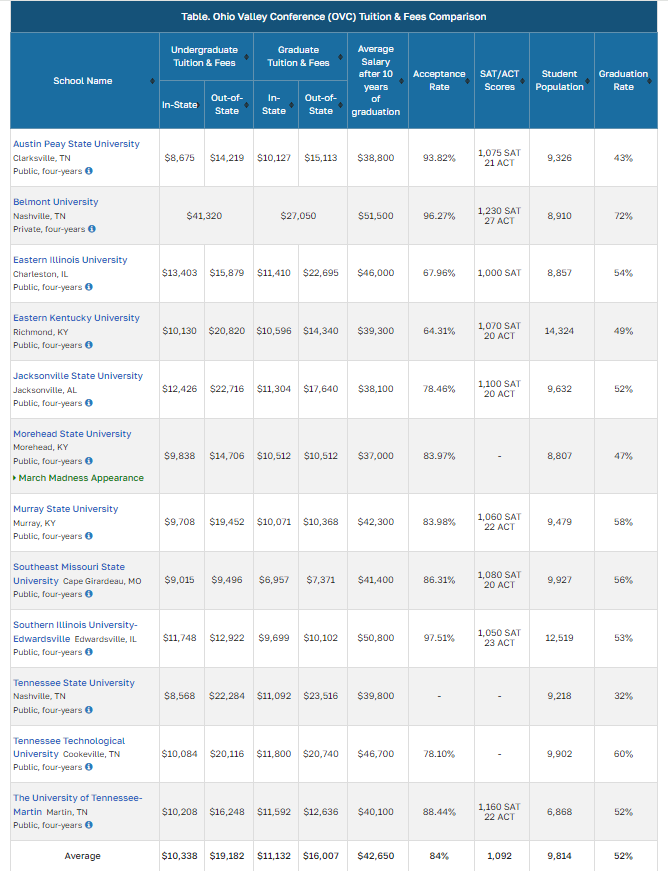
The report from the Commission on Equitable Public University Funding should be dismissed outright.
The Commission applauds themselves for this “higher education funding formula unlike any other in the nation.” That’s probably a red flag to taxpayers.
The Commission’s report reveals the bias in higher education towards DEI and assumptions about minority students and their resiliency. It invites more questions, including questions about the trustworthiness of those who sat on the Commission and those that funded it.
This Commission was funded by Leftist organizations that could easily fill the funding gap on their own if they wanted to. From the report: “we are grateful for the support of funding partners, including CME Group Foundation, Crown Family Philanthropies, Joyce Foundation, Steans Family Foundation, and anonymous foundations, who provided the financial resources needed to carry out a project of immense scope, scale, and impact.”
The Commission asks the taxpayers to provide $1.4 Billion in new funding to meet the goals stated in the report. This amount is about the same amount the state will spend on support for newly arrived illegal aliens and non-citizen healthcare this year. Budgets are about priorities – and the Democrats have chosen illegals over minorities.
The Commission fails to address the higher cost of Illinois higher education. This is a massive, glaring mistake. Members and funders of the TWO-YEAR effort to revamp how we fund education should be embarrassed about not addressing the issue of cost.
The Commission failed to note the impact on federal grants, which could be upwards of $750 Million dollars. According to State Senator Rose, because the racist funding formula violates federal education law, the universities risk losing all federal grants.
Is there some administrative office people must go to and turn in their common sense to be issued a work badge in higher education? That appears to be what happened to the bureaucrats who rolled out this plan.
Maybe we have an efficiency problem instead. Rather than focusing on equity and letting diversity faculty run a funding commission, maybe instead the University of Illinois can have their professors at their highly regarded business school sharpen their pencils and get to work on optimizing operations.
The Illinois Board of Higher Education, progressive Democrat state legislators, and university presidents have devised a plan to fund higher education based on race.
These over-educated elitists sitting in their academic bubble and seeping in their racial equity dogma have literally put a price on students based only on race.
One of their proposed adjustments for additional money assigns a Black student’s worth at $6,000, a Hispanic student $4,000, and a student from a rural district $2,000. If they admit a Black rural student, then the “Equity Adjustment” is stackable to a maximum of $8,000.
White and Asian students don’t merit any additional money.
The highly credentialed academics spent two years on their plan. But a simple reading of the Civil Rights Act and the recent Supreme Court decision forbidding race-based admissions should have prevented them from wasting their time.
New Higher Education Funding Report Says Illinois Higher Education is Systemically Racist.
In March 2024, the Commission on Equitable Public University Funding released the results of their study in a 89-page report which is linked HERE. That Commission was established under Public Act 102-0570 in 2021 under the premise that Illinois higher education is systemically racist. The opening lines of the Public Act notes, “Historical and continued systemic racism has created significant disparities in college access, affordability, and completion for Black, Latinx, and other underrepresented and historically underserved students in this State.”
The goal of the Commission, according to the report, was to recommend, “specific data-driven criteria and approaches to the General Assembly to adequately, equitably, and stably fund public universities in this State and to evaluate existing funding methods.”
The full Commission included “33 members, with representatives from the General Assembly, each of the 12 universities, advocacy organizations, fiscal policy organizations, faculty, a health care expert, a legal expert, a public university student, and a member of the Illinois Student Assistance Commission.”
Apparently, common sense was checked at the door before every commission meeting.
These experts made recommendations to, “recognize and address both the historic inequities underlying Illinois’ access and attainment gaps among different groups of students as well as the unique institutional missions and characteristics across the state.”
However, what’s obvious is that the entire aim of the report is to get a guarantee in law for more funding for higher education. To sell that increased funding, the bureaucrats wrapped their findings in equity arguments and asserted that universities are currently underfunded.
The Commission acknowledges that they are dove-tailing off the passage of the Evidenced-Based Funding formula passed in 2017, which changed how we fund K-12 education in Illinois. That model has pushed billions in new funding to local schools based on the notion that schools in Illinois were not adequately funded, and if only they were, then academic achievement would follow.
Like the EBF model – the Equity Adjustment Funding EAF (my abbreviated term) even calls for a hold harmless provision in the funding formula so that base funding never drops at any university. This provision alone, written into law, ensures school districts and campuses are never consolidated and right-sized.
If the System’s Racist, Who’s Running the System?
Let’s look again at the impetus for the Commission – to correct systematically racist policies in higher education that have prevented underrepresented minorities from graduating.
The report includes this chart to illustrate what they say is systemic racism. It simply show that minority enrollment has declined 7% for Latinos and 6% for Blacks in the last five years. White enrollment is also down 3.5%. This isn’t unusal. Illinois enrollment between 2012 and 2022 dropped 27%. It’s likely students are finding more affordable options elsewhere.
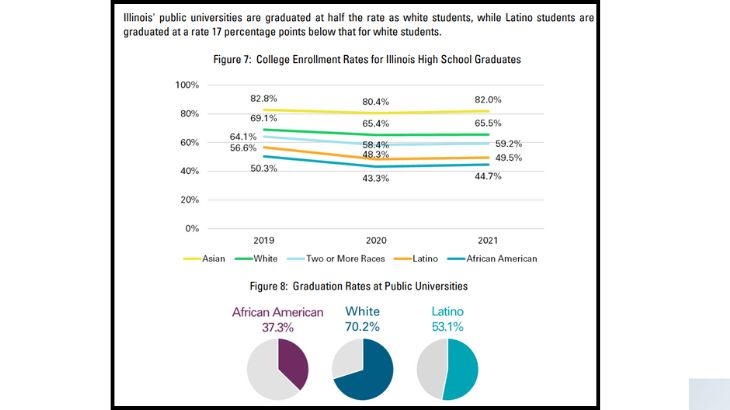
The chart says nothing as to why minority students are not entering and graduating at the same rates as white and Asian (also a minority) students. In actuality, Illinois public universities are bending over backward to take in minority students and give them fully funded educations, and they have been doing so for years. Seven years ago, at a private meeting with the Chancellor for UIC in his office, he said that 40% of the students pay less than $4,000 to attend school there. If that’s not affordable, then I don’t know what is.
Just two weeks ago, the NIU President bragged in a House hearing that 43% of the students pay no tuition or fees to attend. She also mentioned a special scholarship NIU grants just for Black students and that the Hispanic enrollment at NIU has reached new highs as they aggressively recruit Hispanic students.
In that same hearing before the Illinois House Appropriations Committee on Higher Education, the representative from the Illinois Board of Higher Education bragged about bringing in people from the Department of Human Services to assess students’ qualifications for food stamps, state-paid childcare, and housing support. In Illinois, they are signing kids up for classes and enrolling them in public aid programs at the same time.
A second chart is so nakedly racist and demeaning it is hard to believe that the Commission put it together.
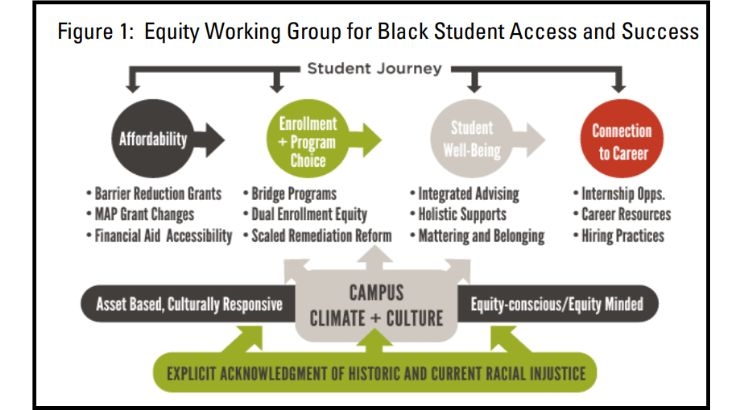
It’s as if the goal was to put as many diversity cliques and terms as possible in one chart. What does this all mean? What appears to be happening is that instead of pulling students along the success path, the system described above carries them through, providing a safety net at every point, requiring little self-motivation from the student. This chart depicts a racist system and assumes that minority students can’t make it on their own.
On page 25 of the report, the Commission shows the numbers for one of the Equity Adjustments in the new funding formula. The formula, just like EBF, is overly complicated. Additional Equity Adjustments are made based on the concentration of minorities at each institution. This chart shows the different economic value to universities of the different races. This formula would incentivize universities to admit minorities for greater funding. Here’s where the value of $6,000 for a Black student, $4,000 for a Hispanic, and $2,000 for a rural student comes from.
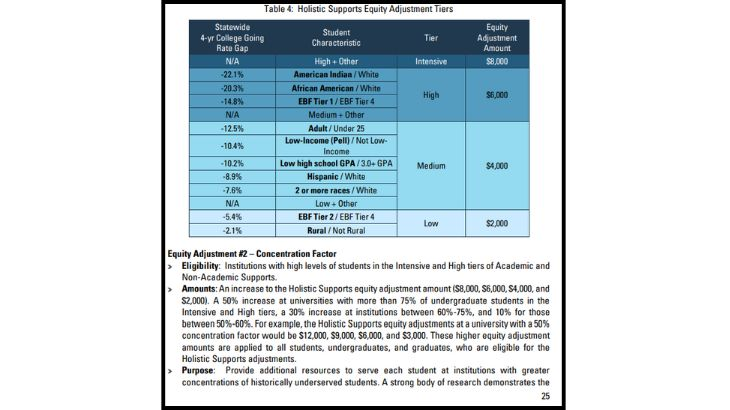
An Alternate View on Education Funding in Illinois and Comparison to Other States
The Commission report fails to tell the whole story about higher education funding in Illinois. The State Higher Education Executive Officers Association FY22 Finance report explains all the gaps – all the other information that is important to assess.
The following charts come from the report referenced above.
Illinois ranks number one in the amount of state support for higher education, giving nearly $23,000 in funding per student to our universities.
The next closest state is Alaska at $18,436. The U.S. average is $10,237.
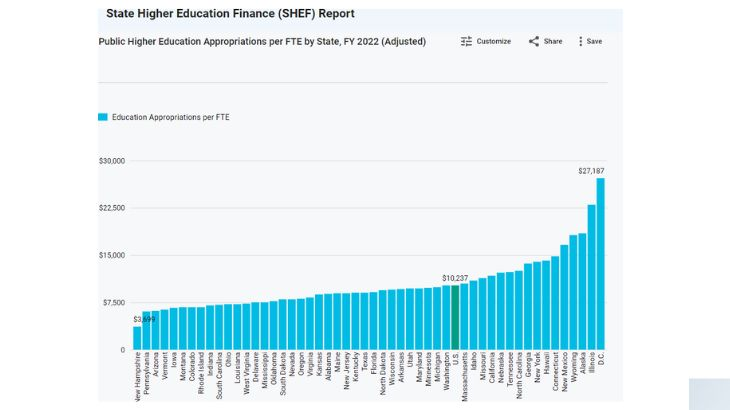
Here’s a similar chart showing both state support and tuition and fees collected. Again Illinois is NUMBER 1 – by a longshot!
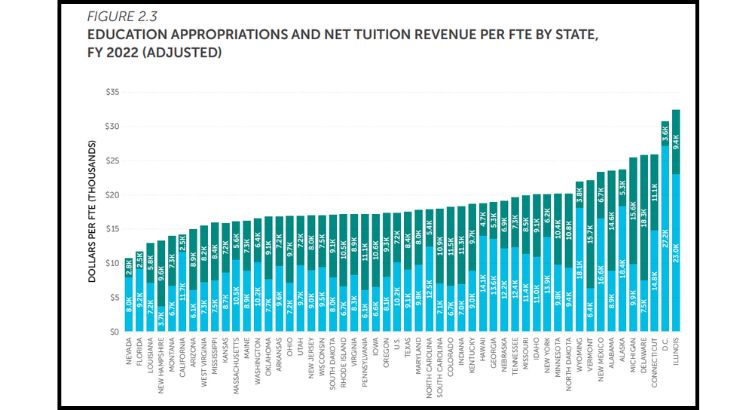
Maybe the Commission can understand a color-coded map better than a complicated graph. Illinois stands out in this chart showing how much taxpayers are already burdened with in support of higher education.
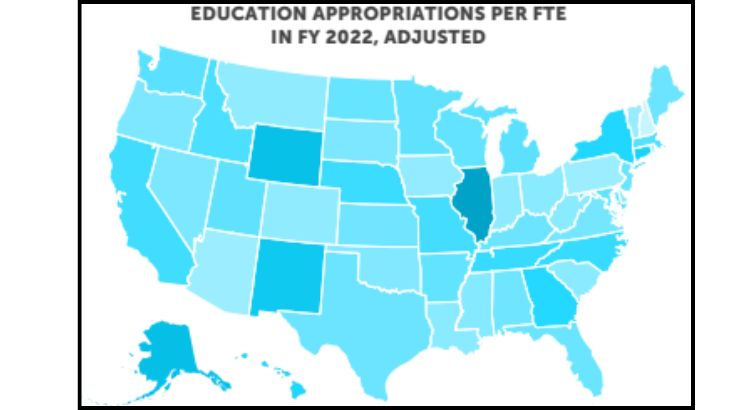
Let’s go a little further. In testimony last week, U of I President Killeen said that their funding is way behind inflation and, without being specific about the timeframe, that their buying power has decreased by 40% over decades.
The Commission included the chart below in their report to make a similar point.
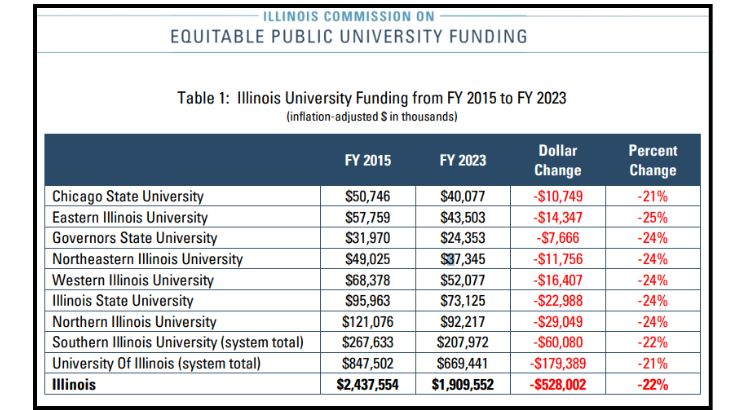
While buying power decreased from FY15-FY23, guess what else has decreased in Illinois – overall enrollment.
SHEEO analysis shows is enrolllment in Illinois universities dropped 27% between 2012 and 2022. President Killeen should be arguing for consolidation and right-sizing of our university system instead of blanket increases. Shockingly, Illinois is the only state to have lost enrollment since 1980. (To see the chart more clearly, go to page 38 of this report https://shef.sheeo.org/wp-content/uploads/2023/05/SHEEO_SHEF_FY22_Report.pdf)
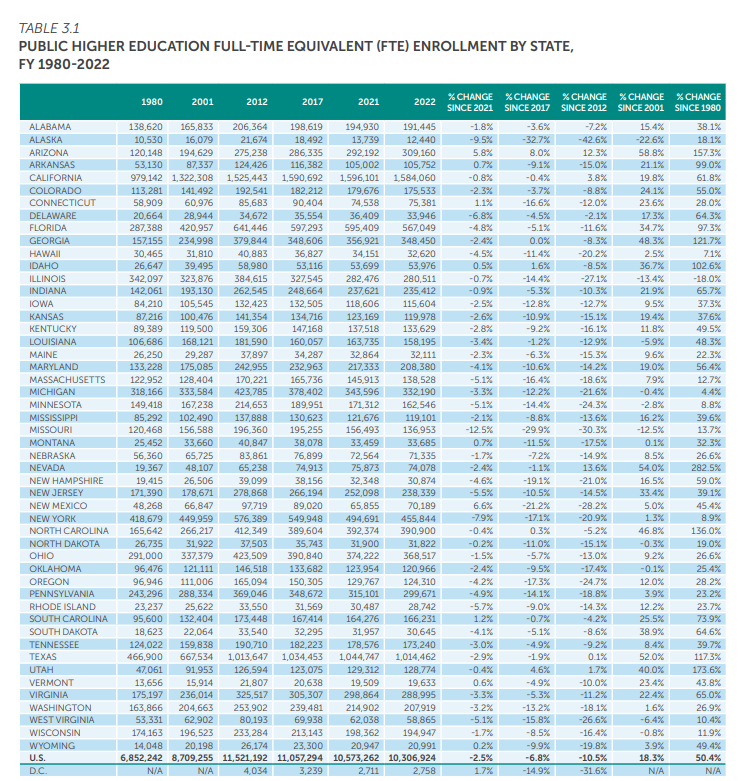
Another chart from that same report shows that Illinois has outpaced other states in the increases in state spending. Since 2012, state spending on higher education is up 53%. (This graph is on page 45 of the report linked above.)
Illinois spending per FTE was $14,975 in 2012 and increased to $22,970 in 2022. As the Commission indicated, spending has increased even more in the last two years.
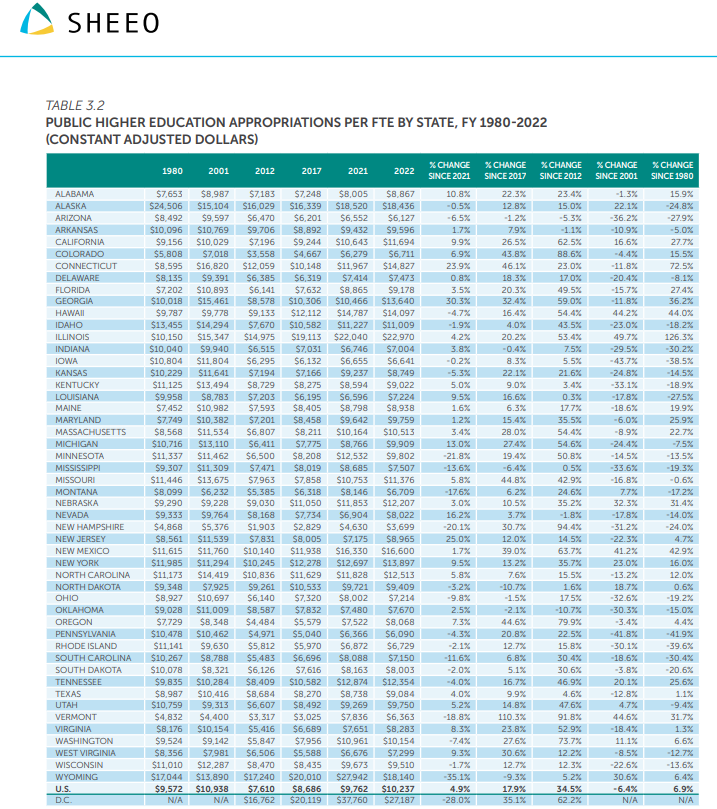
NOW – I already know what people in higher education are going to say about the SHEEO information on spending. They are going to say that SHEEO includes Illinois spending on pensions in their calculation of state support. Yes, they do! And they should – it is a massive amount of money and a cost to the taxpayer. Pension costs account for about 40% of the state-level support for higher education in Illinois. But, even accounting for 40% of support going to pensions, Illinois is still in the top ten for state-level support to higher education.
Illinois is More Expensive Than Its Peers
The EIU President mentioned in testimony last week that he was proud that Eastern Illinois University has the lowest tuition and fees among Illinois public universities. Compared to its peers in the Ohio Valley Conference, however, it is the most expensive among other public institutions. Here is a chart from this source: https://www.collegetuitioncompare.com/best-schools/ohio-valley-conference/
EIU instate undergraduate tuition and fees is $13,403 . The average in their conference is $10,338, making EIU 30% higher than the average of their peer institutions. The outlier in the chart is the private school Belmont University at $41,320.
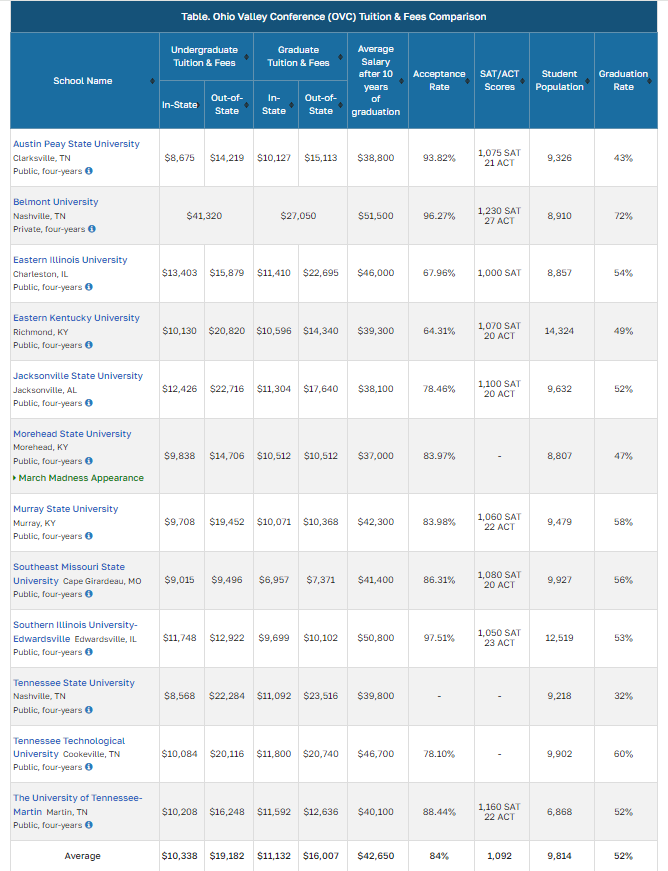
The report from the Commission on Equitable Public University Funding should be dismissed outright.
The Commission applauds themselves for this “higher education funding formula unlike any other in the nation.” That’s probably a red flag to taxpayers.
The Commission’s report reveals the bias in higher education towards DEI and assumptions about minority students and their resiliency. It invites more questions, including questions about the trustworthiness of those who sat on the Commission and those that funded it.
This Commission was funded by Leftist organizations that could easily fill the funding gap on their own if they wanted to. From the report: “we are grateful for the support of funding partners, including CME Group Foundation, Crown Family Philanthropies, Joyce Foundation, Steans Family Foundation, and anonymous foundations, who provided the financial resources needed to carry out a project of immense scope, scale, and impact.”
The Commission asks the taxpayers to provide $1.4 Billion in new funding to meet the goals stated in the report. This amount is about the same amount the state will spend on support for newly arrived illegal aliens and non-citizen healthcare this year. Budgets are about priorities – and the Democrats have chosen illegals over minorities.
The Commission fails to address the higher cost of Illinois higher education. This is a massive, glaring mistake. Members and funders of the TWO-YEAR effort to revamp how we fund education should be embarrassed about not addressing the issue of cost.
The Commission failed to note the impact on federal grants, which could be upwards of $750 Million dollars. According to State Senator Rose, because the racist funding formula violates federal education law, the universities risk losing all federal grants.
Is there some administrative office people must go to and turn in their common sense to be issued a work badge in higher education? That appears to be what happened to the bureaucrats who rolled out this plan.
Maybe we have an efficiency problem instead. Rather than focusing on equity and letting diversity faculty run a funding commission, maybe instead the University of Illinois can have their professors at their highly regarded business school sharpen their pencils and get to work on optimizing operations.





 Alerts Sign-up
Alerts Sign-up